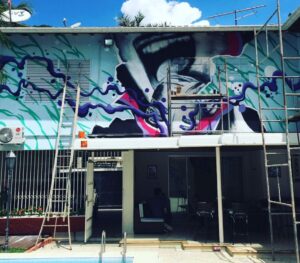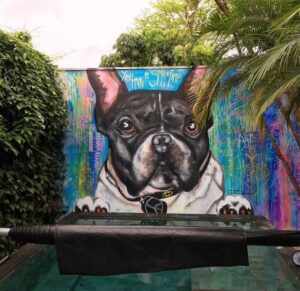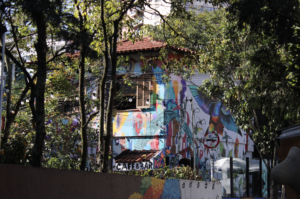
by Khulan Erdenedalai
For many outsiders, Brazil conjures images of extravagant Carnival celebrations, the passionate embrace of soccer—or futebol, as it’s correctly called—and the rhythmic melodies of music such as Bossa Nova and Samba that resonate with the soul. These quintessential elements of Brazilian culture have charmed the world for decades. However, during an initial taxi ride through the vibrant streets of São Paulo, one is quickly introduced to a captivating layer of the city’s identity.
Amidst the dynamic urban landscape, an unseen artistic narrative flourishes. The towering structures are transformed into a different kind of canvas, filled with intricate murals, mesmerizing stencils, and lively graffiti. This tapestry of creativity was a revelation; São Paulo was unlike any other city with so much street art to take in.
This article is the result of engaging with several graffiti artists, gaining insights into the history of street art and uncovering its cultural significance. Discovering this hidden realm of creativity opens a whole new angle on São Paulo’s diverse identity.
History: From Expression to Transformation
Street art in São Paulo wasn’t always embraced as it is now. It emerged as a potent expression of the people’s voices, serving as a platform for social commentary and urban space reclamation.
The origins of São Paulo’s vibrant street art scene, as reported by The New York Times, can be traced back to the early 1980s—a pivotal era during Brazil’s transition from a military dictatorship to a burgeoning democracy. This period saw a group of innovative individuals aiming to transplant the foundational elements of hip-hop culture, which emerged in New York City in the 1970s, to São Paulo’s urban landscape. These pioneering artists formed tight-knit groups centered around breakdancing, hip-hop music, and graffiti artistry. This convergence marked a transformative moment, allowing these artists to turn blank city walls into expressive canvases and platforms for social critique. Graffiti’s rise was closely linked to the ethos of hip-hop culture, which had become a global phenomenon, influencing artists worldwide as it integrated with local cultures and took on unique forms. It provided an influential channel for raw emotions and calls for societal change, resonating deeply with the experiences and struggles of São Paulo’s young artists.

São Paulo’s street art scene gained international attention in the early 2000s. Notable artists like twin brothers Gustavo and Otavio Pandolfo, collectively known as “Os Gêmeos,” along with Eduardo Kobra (“Espeto”) and “Zezão,” gained prominence. In a conversation with Diego Alcenso Lemos (DAL), a local artist and muralist whom I had the pleasure of interviewing, he explained that these artists, many of them now in their 50s, significantly elevated the global awareness of graffiti culture. As DAL remarked, “[these artists] bring hope to other artists to become as known as they are. However, it’s important to note that the essence of graffiti is not something that [artists] do for being famous or getting noticed. It is something to express themselves and their style.”
Legal vs. Illegal: The Discourse of Expression
Beneath the surface of São Paulo’s evolving street art scene lies a nuanced discourse that grapples with the intersection of artistic expression and legal boundaries.
Critics of unauthorized street art, spanning property owners, developers, city officials, and various community members, argue that it straddles a delicate line of property rights, potentially contributing to the degradation of urban aesthetics. They argue that unapproved murals, however captivating, challenge the sanctity of ownership and established norms. Concerns arise over potential property devaluation and the impact on neighborhood aesthetics. The issue of public safety is also a key contention, stemming from unregulated and unvetted artwork.
In contrast, advocates champion street art as a unique channel for artistic expression that transcends conventional galleries. They highlight its power to start conversations, raise social consciousness, and foster community connections. Advocates underline the transformative nature of street art in revitalizing forgotten spaces, reimagining them into dynamic narratives reflecting the pulse and identity of the city.
“People don’t like pixação because the letters look ugly,” says CLICK, a local street photographer and graffiti artist. “It is popular because the first thing you do when you pick up a spray paint is write your name. Then it evolves into graffiti art, getting better and better.” This statement encapsulates a particularly intriguing facet of the street art discourse, one that revolves around “pixação,” an angular and cryptic lettering style that challenges artistic conventions. Often executed in precarious and inaccessible locations, pixação symbolizes rebellion against societal norms. Its defiance of property rights and its raw authenticity add depth to the ongoing conversation, posing fundamental questions about the boundary between art and vandalism. Pixação serves as a compelling entry point into the world of street art, where the journey often begins with the simple act of writing one’s name and evolves into the intricate realm of graffiti art, continually improving and expanding.

Urban Initiatives Fostering Street Art
São Paulo’s response to this complex debate has evolved, reflecting a maturation in the city’s attitude toward street art. Certain neighborhoods have embraced street art as a way to enrich their cultural scene and attract tourists, while others have established strict regulations and penalties for unauthorized works.
A significant emblem of this transformation is the “Open Museum of Urban Art” (Museu Aberto de Arte Urbana) located in the Santana district, an area historically regarded as the birthplace of graffiti in São Paulo. The idea of the museum emerged from an incident in 2011 where eleven graffiti artists were apprehended after creating unauthorized works on the pilasters of METRO stations. This event marked a pivotal moment for these artists, including Binho, one of the organizers, who saw a chance to turn challenges into catalysts for change. Collaborating with government agencies, they established what they proudly dubbed the world’s first Open Museum of Urban Art.
Binho recalls in a popular Brazilian newspaper, Governo do Estado de São Paulo, “We decided to paint on our own and then the bug caught on. At the police station, we matured the idea, drafted a project, and presented it to the State Secretariat for Culture, the president of the Metrô, and the director of SP-Urbanismo. [Others] joined the partnership and now we are offering São Paulo the first Open Museum of Urban Art, unprecedented in Brazil and in the world.”
São Paulo’s decision to allow such artists to reshape neighborhoods into open-air museums presents an alternative to punitive measures. Through initiatives like “Open Museum of Urban Art” the city collaborates with local artists, inviting them to create large-scale murals on building façades, artists are equipped with the necessary resources and materials to bring their creative visions to life. By providing a legal and supportive platform, the city seems to have effectively harnessed their talents to enhance and rejuvenate public spaces.
Batman Alley (Beco do Batman), a well-known tourist attraction featuring a variety of graffiti in Vila Madalena, has gained a kind of “protected” status due to its cultural significance. This protection often means safeguarding the street art from efforts to erase or remove it, preserving it as an essential part of the neighborhood’s identity. The success of the street in promoting tourism and fostering community engagement has led to greater acceptance and even collaboration between artists, local authorities, and property owners. Most of the time, property owners in these areas are willing participants, allowing artists to use their walls as canvases. It was in this lively environment that I had the opportunity to engage with the local street art scene and interact with artists such as Diego Alcenso Lemos (DAL) and CLICK.
DAL provides insight into the phenomenon: “When graffiti got popular, people started wanting murals on their properties and the city council started to hire people to make art for the people. So, São Paulo became the capital of graffiti in Brazil because it is where you find the most quantity and quality of artists.” While talented graffiti artists exist beyond São Paulo, the city’s vastness accelerates graffiti’s growth due to its population of 20 million—providing ample space for creative expression.
Another intriguing facet of this system pertains to the penalties imposed on caught artists. CLICK reveals that apprehended artists are often presented with a choice: pay a fine or engage in community service. This service could encompass teaching graffiti courses or providing assistance to marginalized individuals, such as distributing essential supplies like “food baskets.” The concept of teaching graffiti courses particularly stands out, indicating São Paulo’s embrace of alternative approaches that channel creative energy into positive outlets, once again.

Street Artists: Their Inspirations and Challenges
Street art in São Paulo initially emerged as a response to political conditions, yet its evolution has led to a diverse array of contemporary street artists drawing inspiration from various sources and hailing from different backgrounds.
Diego Alcenso Lemos (DAL) recounted his artistic journey, which began in graphic design, where he customized products for major brands like Adidas and Instagram. Following his graphic design work, DAL ventured into the world of street art and murals. Despite his background in classical painting, he acknowledges that graffiti demands resilience and is a challenging art form. He candidly shared, “I bought some cans and started to paint small murals. I felt frustrated at first. Working with sprays is very hard; it requires precise control to paint with spray paint.”
DAL continued, “I took what I learned from classical painting and applied those techniques to graffiti. Gradually, my murals improved. I started receiving interest from people seeking my artwork. I began working on murals for clients and expressing myself on the streets. I don’t see myself as an outsider, but rather someone who took a different path. I came from a classical art background and transitioned to graffiti. It’s interesting because while some people transition from street art to galleries, I did the opposite. This contrast is fascinating as today’s art community is diverse, with individuals from various places and backgrounds.”
In a contrasting artistic journey, CLICK’s origins were rooted in photography. He captured the essence of São Paulo’s culture, including the fervor of futebol and urban life in informal settlements known as favelas. CLICK’s street art also revolves around Brazilian culture. He emphasized that while many artists still create politically themed works, he observed an upswing after the assassination of feminist and human rights activist Marielle Franco in 2018. Numerous murals now honor her legacy, along with critical depictions of former Brazilian President Jair Bolsonaro.
Inquiring about challenges faced by street artists, I received an insightful response from CLICK. For him, financial constraints related to spray paint cans can be a hurdle. He explained, “Twenty years ago, spray paint was more expensive. Graffiti isn’t as costly as it used to be, but the expenses of spray paint do add up. Rich individuals have the conditions to create more beautiful art.”
These artists’ stories shed light on the diverse backgrounds and perspectives that contribute to São Paulo’s vibrant street art scene. The journey of each artist underscores the city’s evolving artistic landscape and the sources of inspiration that fuel their creations.
São Paulo’s street art scene is a captivating narrative of expression, transformation, and community. Emerging originally as a form of rebellion against oppressive political conditions, street art has evolved into a significant cultural force that not only remembers its roots but also fosters dialogue and reinvigorates public spaces. Artists found an outlet for their frustrations and a means to challenge the status quo through vibrant and often provocative artwork.
If you find yourself in São Paulo, Brazil, don’t miss the chance to explore Batman Alley, or pick any street and take a leisurely walk to soak in the street art that fills the walls. It’s a vibrant testament to the city’s creative spirit and its ongoing evolution as a hub for street art enthusiasts and artists from around the world.
Khulan Erdenedalai is a junior in Silliman. She can be contacted at khulan.erdenedalai@yale.edu.